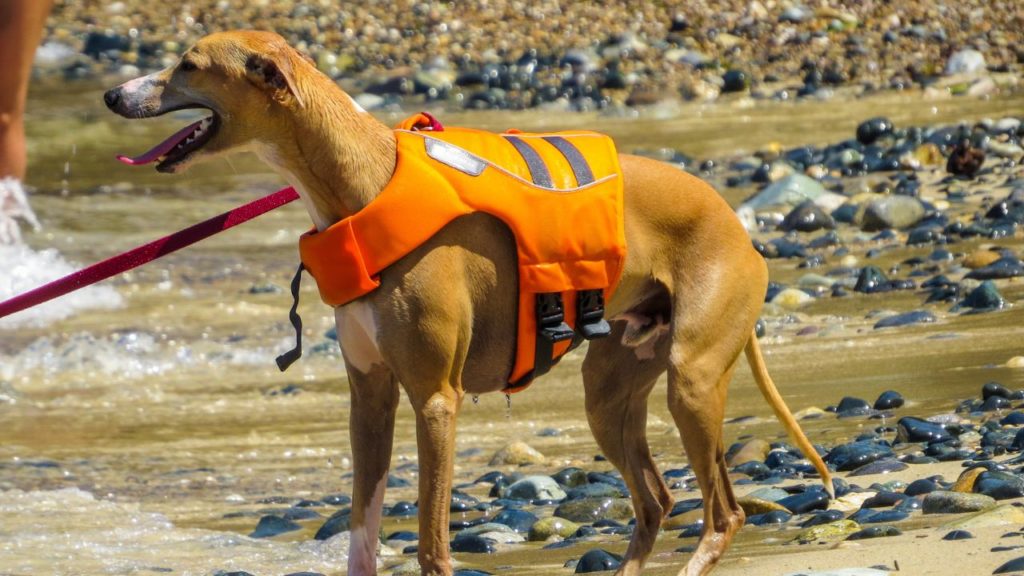
Rescue dogs often need some extra help navigating tricky terrain, and a rescue harness is designed to meet their needs.
From adventure to safety, a dog rescue harness can be useful for many situations. Like, For where you need to pull out the dog while lifting whole its weight, and for instance, if your dog is pulling on the leash behind you and someone steps out unexpectedly in front of you. Yup, that’s right – a rescue harness can help to avoid those not-so-fun “oops” moments.
Everyday life for most dogs offers many opportunities to expose them to potential hazards, like stairs, balconies, and slippery floors. That’s why a dog rescue harness is equipped with special chest fittings that can be used to assist in lifting your dog up and out of those precarious situations.
As well as being an invaluable safety aid for dogs who are less agile or struggling with mobility issues, the padded chest strap on a dog rescue harness makes a good alternative to a dog collar and leash when training your dog to walk on his or her hind legs.
The first thing you’ll want to look for is whether the harness itself is adjustable. While most dog harnesses have a fixed size, some can be adjusted around your pup – just make sure that it doesn’t get too tight or uncomfortable as this could cause injury over time.
If you do want something more defined, consider purchasing a collar and harness set. This style can be adjusted to your dog and will make it easier for you to attach leashes or other gear.
And what about straps? If you’re looking for something to help with mobility issues, look for a padded option as this will be the most comfortable for your pup. Otherwise, choose one with mesh padding or a lightweight design.
You’ll also want to think about how you prefer to use your dog harness. Are you looking for a simpler, casual option? Some models are made with handles and come free of any straps – it’s up to you! There are even some options that include detachable leashes.
On the other hand, you might be looking for a more traditional way to take your dog out on walks. In this case, you may want to try using the harness as an additional safety measure when walking your pup – adding another level of protection is always better!
Finally, consider how you’ll attach all of your gear. Thankfully, most dog rescue harnesses will come with a D-ring to securely attach your leash – but some may not!
This is important for training purposes, too – you’ll want to make sure that you can easily remove the harness from your dog so they don’t get stuck if they start biting or acting up.
If you’re looking for a top-quality dog harness that can be used in various situations, the best place to start is with an adjustable, padded option. Choose from several options at your local pet supply store and determine which style would work best for you!
How Do You Carry an Injured Dog on a Hike?
First of all, make sure to contact your veterinarian and let them know which rescues they should be on the lookout for. If you are unable to get ahold of someone at home, call a local emergency animal hospital instead. Now that we’ve covered the precautionary measures, let’s jump into some step-by-step instructions!
Getting the dog onto a pack is the most difficult part. You should always try to get the animal as close to you as possible, and by that, I mean both physically and mentally.
Make sure they are at least on your direct line of sight, if not in arm’s reach (that being said, if it was me carrying a rescuer, I would want to be holding their head in my hands, and looking them in the eyes).
Get them on your level mentally by talking to them reassuringly. You’re going to have a hard time keeping their mind off the pain while you attempt to get the pack on their back.
I’m going to assume both dog and human are uninjured, so you should have a pack on and ready to go. Be sure your dog has water and food in their packs (you can carry them while the dog is injured, but be kind to your back!).
Also, be sure they have their own first aid kit. If you are out for an extended amount of time, make sure to account for bears in your area.
How Do You Carry a Large Dog in an Emergency?
Well, that really depends on the emergency. If it were me, I wouldn’t be carrying a large dog at all. I would get as much of my own gear off and let the dog use it to cushion against rocks etc.
When possible, find an old sleeping bag or backpacking tent to place between your body and theirs. Try to keep the dog in a standing position so their back doesn’t get crushed under your weight (they are not used to carrying anything significantly heavier than they are).
If the dog is a very large breed (Newfoundlands, Great Pyrenees, Mastiffs) you will have to carry them. This only works if it is just for short distances and the ground is relatively flat (you shouldn’t be dealing with uneven terrain when carrying an injured dog who can’t walk). Pick.
Don’t place them on your shoulders. While we know it’s possible, you will be most comfortable keeping pressure off of your neck and you should have a better sense of balance if they are below you.
You also won’t have to worry about their weight pulling on the straps. Find a flat surface with plenty of padding underneath and lay them down (yes, this is going to make your dog more comfortable, but comfort is key if they are injured).
Get yourself into an equal position under or next to him so you don’t put your body in any uncomfortable or vulnerable positions. This will allow you to have more control over the dog than if they were above you, and it prevents them from being able to turn on you fiercely.
Place one arm below them, under their chest (or legs if the injury is very severe) and place your other arm , palm up, in a position where it can comfortably support some of their weight.
This also allows you to apply pressure by gently pushing down on their abdomen or chest with the “supporting arm”, which will hopefully lessen any pain they’re in.
Pick the four-legged friend up mentally and take them to the nearest animal hospital.
How Do You Carry a Dog in Pain?
If you have a dog who is in pain, whether it be from cancer or something else, please stay with us as we discuss one of the most difficult situations that plague people whose pets are suffering.
We want to provide some guidance to help you through this terrible time so that in the end your pet’s passing will be peaceful and gentle.
Dogs are quick to injure their limbs. If they’re in pain, then you need to take their weight off of them. Continually lifting them with a sling or harness will support the dog’s middle and free up space for the injured leg.
How Do You Calm Down an Injured Dog?
According to the American Kennel Club, touching or petting your dog will increase their pain and should be avoided. The sling provides an easy way to carry them and care for them long enough to get out of harm’s way.
You should speak to your pet in a calm, soothing voice. If you’re extremely upset or panicked, then that will make your pet even more anxious.
How Do You Lift a Dog With a Towel?
For the average size dog, you can use a towel. Place it on the ground and sit down beside your pet. Wrap the towel around their middle and then rise upholding them in your arms.
How Do You Carry a Dog With a Sling?
A sling is an easy way to keep your dog safe while they’re in pain. If you have a younger dog, then it’s fine to use the towel method. However, if your pet is older or larger, then we suggest using a sling instead.
Providing support for their head and neck will be easier with the sling than with a towel.
How Do You Lift a Dog With a Back Injury?
You can lift a dog with a back injury, but you need to be extremely careful with the process. It is important you don’t do anything that would make any damage worse, so it is better that you ask your vet and professionals how to do this without causing further injury to the dog’s back.
If not for a back injury, lifting a dog can be done by placing one of your arms under the front legs of the dog with her chest pointing upwards while holding onto one of her hind legs with your hand placed on top of her foot.
You then lift using both hands raised towards its rear end using no more than five pounds of pressure. Make sure when doing so that it does not intensify any pain or discomfort from its back. When lowering a dog, you can gently lower it.
